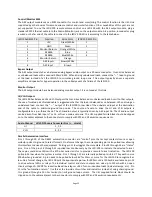
Page 42
will change to that level when the format is selected. If the format does not have a preset fader level, the fader
will change to the level last used on that format. The
last used
fader level memorizes “on the fly” fader
adjustments. If the operator turns down the fader during the preshow and then switches to Digital 16 for the
movie, the fader level will return to the newly set level for preshows the next time that format is selected.
The main power switch turns the JSD-100 on and off. When the power is off, the JSD-100 enters bypass mode if
the bypass power supply is plugged in. The bypass system in the JSD-100 uses completely separate electronics to
generate a monaural signal that drives the left and right main audio outputs. The front panel switches and fader
operate the same in bypass and normal modes. All inputs except microphone are available in bypass mode.
8.2
Automation
The JSD-100 accepts external control (such as automation) over Ethernet, RS-232, and a parallel automation port.
The JSD-100 accepts up to 5 simultaneous TCP connections on port 10001. A digital cinema server can send
commands to the JSD-100 through a TCP connection. The command structure is described in Appendix B.
The JSD-100 accepts commands over the RS-232 port. The hardware interface is described in the installation
section. The commands are described in Appendix B.
The JSD-100 accepts and generates parallel automation pulses on the DB25F rear panel automation
connector. Pulsing pin 1 to ground is the same as pushing the first button on the front panel (COAX 1). Pulsing
pin 2 to ground is the same as pushing the second button. The parallel automation interface is described in
more detail in Section 6.8.
8.3
System Monitoring
A large number of JSD-100 systems can be monitored simultaneously over
Ethernet. Multiple units can be monitored and controlled using the GUI.
Multiple units can be monitored and controlled using a web browser. The
web interface duplicates the front panel controls, allowing selection of input,
setting fader level, and muting the system. Multiple units can be monitored
using SNMP.
8.3.1
GUI View of Multiple JSD-100s
The GUI main screen provides an overview of several JSD-100 systems. Systems are normally broken into groups
representing theaters. Each group contains the individual JSD-100 systems for each auditorium.
Adding Groups
Create a group for each theater. The group is a collection of JSD-100s, one
in each auditorium.
Click the “Groups” button at the top of the screen.
Click “Add”. You will be prompted to enter the name of the new
group.
Click “OK” when you have finished adding groups.
Summary of Contents for JSD-100
Page 12: ...Page 12...
















































